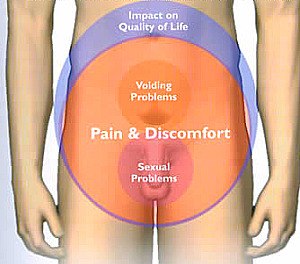
Chronic pelvic pain syndrome (CPPS)
Chronic pelvic pain syndrome may also be called chronic prostatitis or Non-bacterial prostatitis. This often distressing condition affects around 11% of men between the ages of 20-50 years and 9% of men over the age of 50.
Research undertaken at Stanford University has shown that chronic pelvic pain syndrome may be linked to tightness or spasticity of the muscles in the pelvis including the pelvic floor. This may lead to the formation of tight, painful bands within the muscle called Trigger Points. These painful bands of muscle can refer pain to the groin , testicles, perineum, lower back and inner thighs.
Copyright © 2012 Womens Health Physiotherapy. All Rights Reserved.


WOMENS HEALTH
PHYSIOTHERAPY AND
ACUPUNCTURE

Symptoms of CPPS, chronic prostatitis / chronic pelvic pain include:
- Pain / discomfort in the lower abdomen, groin, pelvis and back
- Rectal pain often described as a "golf ball" type pain
- Perineal and genital pain which can include the scrotum and penis
- Pain on or after ejaculation
- Difficulty passing urine
- Urgency and frequency of the bladder
- Pain / discomfort after sitting
Treatment
An individual treatment plan will be discussed with you following your assessment. It may be based around the recommendations made within the Wise / Anderson protocol (Stanford
Protocol) for the treatment of chronic pelvic pain which suggests that treatment from a specialist physiotherapist includes
- Assessment of the back, pelvis and pelvic floor
- Specific Trigger Point release (TPR) of external and internal trigger points around the pelvic area including those found within the pelvic floor
- Soft tissue therapy, Myofascial release and massage
- Training in relaxation methods
- Acupuncture for pain relief
- Self management advice
All advice and treatment is given by an experienced physiotherapist who has had specialist training to deal with issues related to mens health.
Contact us at Womens Health Physiotherapy today and arrange your assessment.